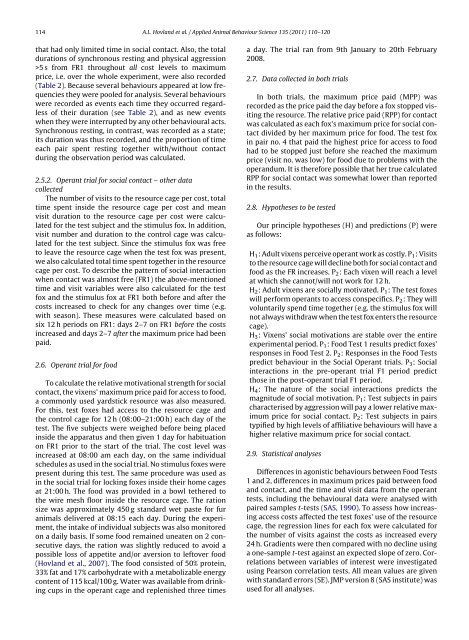Hovland et al. 2011.pdf - Atrium - University of Guelph
Hovland et al. 2011.pdf - Atrium - University of Guelph
Hovland et al. 2011.pdf - Atrium - University of Guelph
You also want an ePaper? Increase the reach of your titles
YUMPU automatically turns print PDFs into web optimized ePapers that Google loves.
114 A.L. <strong>Hovland</strong> <strong>et</strong> <strong>al</strong>. / Applied Anim<strong>al</strong> Behaviour Science 135 (2011) 110–120that had only limited time in soci<strong>al</strong> contact. Also, the tot<strong>al</strong>durations <strong>of</strong> synchronous resting and physic<strong>al</strong> aggression>5 s from FR1 throughout <strong>al</strong>l cost levels to maximumprice, i.e. over the whole experiment, were <strong>al</strong>so recorded(Table 2). Because sever<strong>al</strong> behaviours appeared at low frequenciesthey were pooled for an<strong>al</strong>ysis. Sever<strong>al</strong> behaviourswere recorded as events each time they occurred regardless<strong>of</strong> their duration (see Table 2), and as new eventswhen they were interrupted by any other behaviour<strong>al</strong> acts.Synchronous resting, in contrast, was recorded as a state;its duration was thus recorded, and the proportion <strong>of</strong> timeeach pair spent resting tog<strong>et</strong>her with/without contactduring the observation period was c<strong>al</strong>culated.2.5.2. Operant tri<strong>al</strong> for soci<strong>al</strong> contact – other datacollectedThe number <strong>of</strong> visits to the resource cage per cost, tot<strong>al</strong>time spent inside the resource cage per cost and meanvisit duration to the resource cage per cost were c<strong>al</strong>culatedfor the test subject and the stimulus fox. In addition,visit number and duration to the control cage was c<strong>al</strong>culatedfor the test subject. Since the stimulus fox was fre<strong>et</strong>o leave the resource cage when the test fox was present,we <strong>al</strong>so c<strong>al</strong>culated tot<strong>al</strong> time spent tog<strong>et</strong>her in the resourcecage per cost. To describe the pattern <strong>of</strong> soci<strong>al</strong> interactionwhen contact was <strong>al</strong>most free (FR1) the above-mentionedtime and visit variables were <strong>al</strong>so c<strong>al</strong>culated for the testfox and the stimulus fox at FR1 both before and after thecosts increased to check for any changes over time (e.g.with season). These measures were c<strong>al</strong>culated based onsix 12 h periods on FR1: days 2–7 on FR1 before the costsincreased and days 2–7 after the maximum price had beenpaid.2.6. Operant tri<strong>al</strong> for foodTo c<strong>al</strong>culate the relative motivation<strong>al</strong> strength for soci<strong>al</strong>contact, the vixens’ maximum price paid for access to food,a commonly used yardstick resource was <strong>al</strong>so measured.For this, test foxes had access to the resource cage andthe control cage for 12 h (08:00–21:00 h) each day <strong>of</strong> th<strong>et</strong>est. The five subjects were weighed before being placedinside the apparatus and then given 1 day for habituationon FR1 prior to the start <strong>of</strong> the tri<strong>al</strong>. The cost level wasincreased at 08:00 am each day, on the same individu<strong>al</strong>schedules as used in the soci<strong>al</strong> tri<strong>al</strong>. No stimulus foxes werepresent during this test. The same procedure was used asin the soci<strong>al</strong> tri<strong>al</strong> for locking foxes inside their home cagesat 21:00 h. The food was provided in a bowl t<strong>et</strong>hered tothe wire mesh floor inside the resource cage. The rationsize was approximately 450 g standard w<strong>et</strong> paste for furanim<strong>al</strong>s delivered at 08:15 each day. During the experiment,the intake <strong>of</strong> individu<strong>al</strong> subjects was <strong>al</strong>so monitoredon a daily basis. If some food remained uneaten on 2 consecutivedays, the ration was slightly reduced to avoid apossible loss <strong>of</strong> app<strong>et</strong>ite and/or aversion to leftover food(<strong>Hovland</strong> <strong>et</strong> <strong>al</strong>., 2007). The food consisted <strong>of</strong> 50% protein,33% fat and 17% carbohydrate with a m<strong>et</strong>abolizable energycontent <strong>of</strong> 115 kc<strong>al</strong>/100 g. Water was available from drinkingcups in the operant cage and replenished three timesa day. The tri<strong>al</strong> ran from 9th January to 20th February2008.2.7. Data collected in both tri<strong>al</strong>sIn both tri<strong>al</strong>s, the maximum price paid (MPP) wasrecorded as the price paid the day before a fox stopped visitingthe resource. The relative price paid (RPP) for contactwas c<strong>al</strong>culated as each fox’s maximum price for soci<strong>al</strong> contactdivided by her maximum price for food. The test foxin pair no. 4 that paid the highest price for access to foodhad to be stopped just before she reached the maximumprice (visit no. was low) for food due to problems with theoperandum. It is therefore possible that her true c<strong>al</strong>culatedRPP for soci<strong>al</strong> contact was somewhat lower than reportedin the results.2.8. Hypotheses to be testedOur principle hypotheses (H) and predictions (P) wereas follows:H 1 : Adult vixens perceive operant work as costly. P 1 : Visitsto the resource cage will decline both for soci<strong>al</strong> contact andfood as the FR increases. P 2 : Each vixen will reach a levelat which she cannot/will not work for 12 h.H 2 : Adult vixens are soci<strong>al</strong>ly motivated. P 1 : The test foxeswill perform operants to access conspecifics. P 2 : They willvoluntarily spend time tog<strong>et</strong>her (e.g. the stimulus fox willnot <strong>al</strong>ways withdraw when the test fox enters the resourcecage).H 3 : Vixens’ soci<strong>al</strong> motivations are stable over the entireexperiment<strong>al</strong> period. P 1 : Food Test 1 results predict foxes’responses in Food Test 2. P 2 : Responses in the Food Testspredict behaviour in the Soci<strong>al</strong> Operant tri<strong>al</strong>s. P 3 : Soci<strong>al</strong>interactions in the pre-operant tri<strong>al</strong> F1 period predictthose in the post-operant tri<strong>al</strong> F1 period.H 4 : The nature <strong>of</strong> the soci<strong>al</strong> interactions predicts themagnitude <strong>of</strong> soci<strong>al</strong> motivation. P 1 : Test subjects in pairscharacterised by aggression will pay a lower relative maximumprice for soci<strong>al</strong> contact. P 2 : Test subjects in pairstypified by high levels <strong>of</strong> affiliative behaviours will have ahigher relative maximum price for soci<strong>al</strong> contact.2.9. Statistic<strong>al</strong> an<strong>al</strong>ysesDifferences in agonistic behaviours b<strong>et</strong>ween Food Tests1 and 2, differences in maximum prices paid b<strong>et</strong>ween foodand contact, and the time and visit data from the operanttests, including the behaviour<strong>al</strong> data were an<strong>al</strong>ysed withpaired samples t-tests (SAS, 1990). To assess how increasingaccess costs affected the test foxes’ use <strong>of</strong> the resourcecage, the regression lines for each fox were c<strong>al</strong>culated forthe number <strong>of</strong> visits against the costs as increased every24 h. Gradients were then compared with no decline usinga one-sample t-test against an expected slope <strong>of</strong> zero. Correlationsb<strong>et</strong>ween variables <strong>of</strong> interest were investigatedusing Pearson correlation tests. All mean v<strong>al</strong>ues are givenwith standard errors (SE). JMP version 8 (SAS institute) wasused for <strong>al</strong>l an<strong>al</strong>yses.
















